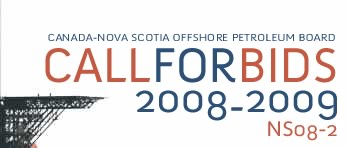
Exploration History
Land Parcel #2
The centre of Parcel 2 is located about 140 km southwest of the western side of Sable Island, in water depths ranging from 1000 to 3500 m. Its western side is bounded by ![]() Parcel 1 of the NS08-2 Call for Bids and the remaining sides are flanked by open crown land. There are no significant discovery licences in this part of the Scotian Basin.
Parcel 1 of the NS08-2 Call for Bids and the remaining sides are flanked by open crown land. There are no significant discovery licences in this part of the Scotian Basin.
Although no wells have been drilled on Parcel 2, four wells were drilled in relatively close proximity: Shubenacadie H-100, Newburn H-23, Weymouth A-45, and Evangeline H-98. Shubenacadie H-100 is the closest well to Parcel 2 and was spudded by Shell in 1982. This well was Nova Scotia’s first deepwater well and Shell was targeting a lower Tertiary turbidite fan as their primary target with a Miocene “bright spot" as a secondary target. The well did not encounter any hydrocarbons and the targeted feature was later determined to be an erosional remnant. Husky’s Evangeline H-98 well, spudded in 1984, is located 22 km north of Parcel 2 and was drilled to test a rollover anticline structure. The well targeted Logan Canyon and Missisauga sands trapped on the hanging wall of a listric fault on the outer shelf, but instead encountered a significantly expanded upper Logan Canyon section dominated by shale (approx. 2600 m). No reservoir quality sands were encountered and the well did not penetrate deep enough to test for any Missisauga equivalent sands.
Newburn H-23 is located approximately 14 km north of Parcel 2, and was drilled by Chevron and its partners in 2002. Chevron anticipated finding lower Missisauga equivalent turbidite sandstone within a detachment fold. Four thin reservoir sands were found above and within the target section. Three of these zones had thin gas pay. Average porosities within these zones range from 14% to19%. Also of note was a channel lag deposit that was recovered from a sidewall core in one of the intervals, this may indicate that the well is located in a bypass or upper slope position. Newburn H-23 established that an active hydrocarbon system is present in the deepwater portion of the southwestern Sable Subbasin, and the presence of coarser clastics indicates that there were periodic influxes of vigorous sediment gravity flows into deepwater during the Early Cretaceous (Chevron et al., 2002).
Weymouth A-45 is located just 12 km east of Parcel 2 and was drilled by EnCana in 2003/2004. It targeted an anticlinal fold interpreted to contain turbidite sands equivalent in age to the Missisauga Formation. This was the basin’s first subsalt test. The well did not encounter any significant hydrocarbons or reservoirs, with the targeted interval consisting mostly of shale and siltstone. Ongoing studies imply that Early Cretaceous sand transport into the Weymouth area may have been hindered by a complex arrangement of salt-related positive bathymetric highs that existed upslope from the well location at the time of inferred reservoir deposition. Sand delivery, therefore, may have been diverted to the east or west of the Weymouth location.
A number of seismic surveys have been acquired over portions of Parcel 2 since the early 1970s. Interpretation reports are available for many of them, with the following table listing the available programs.
| Seismic Program # (links by program) |
Operator (links by company) |
Year |
| Confidential Programs | ||
| 2003 | ||
| 2003 | ||
| 2003 | ||
| 2000 | ||
| 1999 | ||
| 1998 | ||
| 1998 | ||
| Off-Confidential Programs | ||
| 2001 | ||
| 2001 | ||
| 1988 | ||
| 1985 | ||
| 1983 | ||
| 1983 | ||
| 1983 | ||
| 1982 | ||
| 1982 | ||
| 1981 | ||
| 1981 | ||
| 1980 | ||
| 1979 | ||
| 1978 | ||
| 1973 | ||
| 1973 | ||
| 1972 | ||
| 1972 | ||
| 1971 | ||
| 1970 | ||


